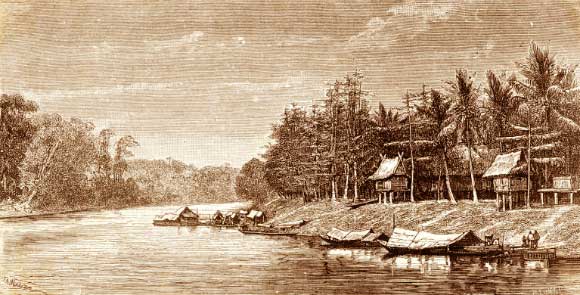New research published in the Proceedings of the National Academy of Sciences provides the first archaeological evidence for an early Southeast Asian presence in the remote island of Madagascar and reveals that this settlement extended to the neighboring Comoros Islands.

An Austronesian village showing several traditional houses, 1893. Image credit: Nationaal Museum van Wereldculturen / CC BY-SA 3.0.
The study authors, led by Dr. Alison Crowther from the University of Queensland in Brisbane, Australia, excavated 18 sites in Madagascar, Comoros, and along the East African coast and recovered over 2,500 seed remains.
They identified that the ancient seeds from Madagascar consist of typically South East Asian crops, such as rice (Oryza sativa), mung bean (Vigna radiate) and cotton (Gossypium arboreum).
“The origins of Southeast Asian settlers in Africa has long puzzled historians and archaeologists,” said co-author Dr. Mark Horton from the University of Bristol, UK.
“This is the first really clear archaeological evidence that they did indeed make extraordinary journeys across 4,000 miles of the Indian Ocean during the first millennium CE.”
The analysis also suggests that Southeast Asians colonized not only Madagascar but also the nearby islands of the Comoros, because again the crops that grew there were dominated by the same Asian species.
“This took us by surprise,” said Dr. Crowther. “After all, people in the Comoros speak African languages and they don’t look like they have Southeast Asian ancestry in the way that populations on Madagascar do.”
“What was amazing to us was the stark contrast that emerged between the crops on the Eastern African coast and the offshore islands versus those on Madagascar, but also the Comoros,” she said.
Genetic research has confirmed that the inhabitants of Madagascar do indeed share close ancestry with Malaysians, Polynesians, and other speakers of what is classed the Austronesian language family.
To date, archaeological research has identified human settlements in Madagascar that belong to the first millennium, but had no definitive evidence that they were of Austronesian origin.
“Southeast Asians clearly brought crops from their homeland and grew and subsisted on them when they reached Africa,” said co-author Dr. Nicole Boivin, from the University of Oxford, UK, and the Max Planck Institute for the Science of Human History, Germany.
“This means that archaeologists can use crop remains as evidence to provide real material insights into the history of the island.”
The scientists examined residues obtained from sediments in the archaeological layers, using a system of sieves and water.
In this process they recovered carbonized seed remains that could be individually identified and directly dated using radiocarbon.
In material from the 8th and 10th centuries CE, they noted a distinct pattern, with African crops concentrated on the mainland and the islands closest to the mainland.
In Madagascar and the neighboring Comoros Islands, in contrast, early subsistence focused on Asian crops.
“There are a lot of things we still don’t understand about Madagascar’s past; it remains one of our big enigmas,” Dr. Boivin said.
“But what is exciting is that we finally have a way of providing a window into the island’s highly mysterious Southeast Asian settlement and distinguishing it from settlements by mainland Africans that we know also happened.”
“Much work remains to be done. We are keen to understand who these people were and what impact they had,” Dr. Crowther said.
“Amongst events that possibly coincide with the arrival of Austronesian speakers is the disappearance of Madagascar’s famous megafauna, which include giant species of birds, lemur, and tortoises.”
Dr. Crowther and co-authors plan to return to Madagascar to continue their research.
_____
Alison Crowther et al. Ancient crops provide first archaeological signature of the westward Austronesian expansion. PNAS, published online May 31, 2016; doi: 10.1073/pnas.1522714113







